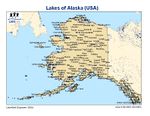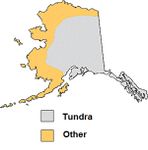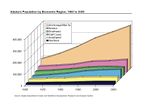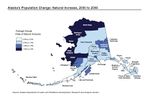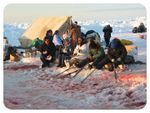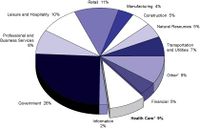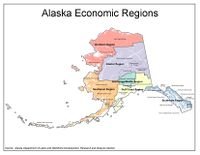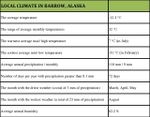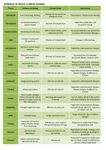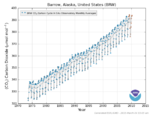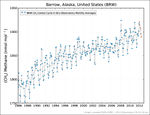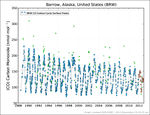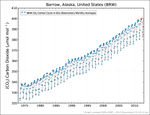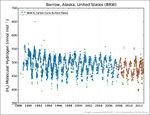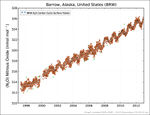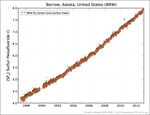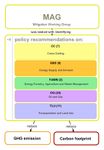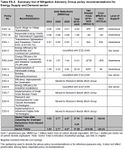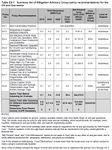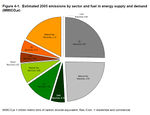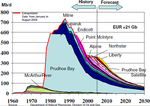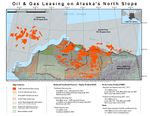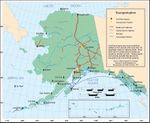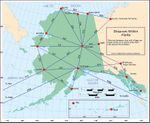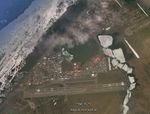Group A - Collaborative Climate Adaption Project
| Place | Barrow | |
| Country | Alaska | |
| Topic | Effects of climate change and adaptation possibilities - case study from Barrow, Alaska | |
| Author(s) | Palmowska Agnieszka, Shrestha Neha, Szilagyi-Nagy Anna | |
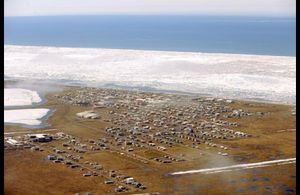
| ||
| Source | http://www.alaskadispatch.com | |
|
| ||
Rationale: Why have you selected this case study area?
- We have selected the area of the city Barrow, which is located in the north of Alaska, because this area is a perfect example to show that climate change is really progressing and causes the changes in many main areas of life. Barrow is known as the "Ground Zero for Climate Change".
- To select this area also encouraged us Dr. Klaus Görgen who talked about problems in Barrow, Alaska, during the first online seminars.
Authors' perspectives
- We are a landscape architects so we are closely associated with the climate, and also we have to constantly adapt to climate change. Showing the problem from the perspective of a place so distant may be helpful in understanding the general problem of climate change and will expand our knowledge about this topic.
- It is important that everyone should be aware that climate change is a global problem and its consequences are visible even in the farthest regions of the world.
Landscape and/or urban context
Urban contex of city Barrow
State, Region, City
- The immediate Barrow situated in Alaska, in the largest and nordernmost state in U.S. (1,477,300 km2, it extends, to the Eastern Hemisphere so the westernmost and easternmost as well) which has more ocean coastline than all of the other U.S. states combined (6640 miles). http://www.fas.org/sgp/crs/misc/RS21729.pdf and a capital, Juneau, that is only accessible via ship or air.
- Barrow is situated in the region North Slope Borough. This region is the remote, less crowded part of the state, encompassing 380 native villages and small towns such as Nome, Bethel, Kotzebue, King Salmon, Dillingham, and includes Katmai National Park, Kodiak Island, and Unalaska-Dutch Harbor. It has 103 capes, 20 glaciers, 147 lakes, 2 beaches, both of them in Barrow, Avac Creek in Barrow is one of the 60 streams, 2 airports of the 41, both of the reservoirs (Isatkoak Reservoir, Nerravak Lagoon), the only one historical radio tower of the region (Loran Radio Tower) and the only one hospital of the area (Samuel Simmonds Memorial Hospital) can be find in Barrow. (http://alaska.hometownlocator.com/ak/north-slope/)Further information about the region can be find here: http://www.city-data.com/county/North_Slope_Borough-AK.html
- Barrow is the most famous city of the Northern Economic Region because it is northernmost town in the United States. With approximately 4,500 residents, the Barrow area has probably the harshest weather in Alaska. It is one of the world's largest Inupiat Eskimo settlement where traditional culture and modern life are blended. While many modern conveniences are available, the subsistence life style is still very much in evidence, and fishing, hunting, and whaling are a way of life. North Slope oil discovery has brought wealth to the area, including modern influences such as snowmobiles, but it has been continuously occupied for 5,000 years by people who have learned how to live in the harsh arctic climate. The sun shines and never sets for 82 days from early May to early August and it is dark for 51 - 67 days (the sun never rises) between November and January.
Settlement developement
The full history of Alaska can be found on the website http://www.akhistorycourse.org/timelines/pre1741.php .
- Barrow is among the oldest permanent settlements in the United States. Hundreds of years before the European Arctic explorers showed up, starving and freezing and succumbing to hardship, Barrow was more or less where it is now, a natural hunting place at the base of a peninsula that pokes out into the Beaufort Sea.
- Archaeological sites in the area indicate the Inupiat lived around Barrow as far back as AD 500.
- Some remains of 16 dwelling mounds from the Birnirk culture of about AD 800 are still in evidence today on the shore of the Arctic Ocean. Their position on a slight rise above the high water mark places them in danger of being lost to erosion within a short time.
- Later, the military came, setting up a radar station, and in 1947 a science center was founded at Barrow.
- The United States Army established a meteorological and magnetic research station at Barrow in 1881, and the Cape Smythe Whaling and Trading Station was established in 1893.
- In 1888 a Presbyterian church was built at Barrow, and in 1901 a United States Post Office was opened.
- In 1972, the North Slope Borough was established. The borough, with millions of dollars in new revenues, created sanitation, water and electrical utilities, roads, fire departments, and health and educational services in Barrow and the villages of the North Slope.
- In 1986, the North Slope Borough created the North Slope Higher Education Center, which later became Ilisagvik College, which is now an accredited two-year college dedicated to providing an education based on the Inupiat culture and the needs of the North Slope Borough.
- In 1988, Barrow became the center of a worldwide media attention when three California Gray Whales became trapped in the ice offshore.[26] After a two week rescue effort (Operation Breakthrough), two of the whales were ultimately freed by a Soviet icebreaker.
Flora and fauna, landscape types
- The landscape consists of polygonized tundra, vegetated drained lake basins, ponds and lakes.
- Vegetation types include aquatic, seasonally flooded, wet, moist, dry and occasionally bare ground. The Coastal Plain flora includes 124 vascular plant species, 177 mosses, and 49 hepatics (Brown 1980).
- Terrestrial fauna include 10 mammal species and 28 bird species.
- Birding in the Arctic: Barrow is one of the top 100 birding spots in America. Although the diversity of birds is somewhat small, the annual visitors are spectacular. All four species of Eider ducks migrate along the coast and nest in the tundra around Barrow. Numerous other ducks and waterfowl also nest in the millions of small puddles and lakes across the tundra. Barrow is also prime habitat for many shorebirds. Perhaps the most spectacular summer visitor and breeder is the snowy owl, from which comes the Inupiat name for Barrow, Ukpeagvik, which translates to "place to hunt snowy owls". Now, of course, the owls are observed and studied. Barrow is the only spot in America one can reliably expect to see the elusive Ross's gull, which shows up, sometimes in great numbers during the last week of September through the first couple of weeks of October.
- Polar Bears & Whales: According to the local tour operators, the very best time to see polar bears is after the fall whaling season. Although it is possible to see them at the Point anytime of the year, October and November allow for the most likely viewing opportunities. In late May and early October, the Eskimo natives go Bowhead whaling. During whaling season there is an opportunity to photograph a whale being brought in on the beach and butchered. Whaling season tends to encourage the polar bears to feast on the remains that are left at Point Barrow. The bears seldom ever make it into town so you would need a tour to see them. The King Eider Inn, in Barrow, has set up a page with a list of the tours available.
- The northeast corner of Alaska is covered by the Arctic National Wildlife Refuge, which covers 19,049,236 acres (7,708,952 ha).
Cultural/social/political context
Population
In Alaska there is a total underserved population of 370,088, representing 59% of the state’s residents. This reflects Alaska’s low population density and extreme rural nature. (acrh-ahec.uaa.alaska.edu) The lowest ratio of the total population live in this area (3.4%) (http://www.labor.state.ak.us/research/pop/present/jan272011.pdf page 2), but it means also the majority of Alaska's native populations (of which approximately 59.3 percent are Inupiat Eskimo.) (http://www.arcticscience.org/aboutBarrow.php), so this is largest Iñupiat town in Alaska (Barrow takes its modern name from Point Barrow, named in 1825 by Captain Beechey of the Royal Navy for Sir John Barrow of the British Admiralty. Beechey was plotting the Arctic coastline of North America at the time. http://www.arcticscience.org/aboutBarrow.php). They traditionally, call the community Ukpeagvik, "place where snowy owls are hunted" and make their living in similar fashion to their ancestors.
Culture and lifestyle
The first people to inhabit Alaska have a rich history of tradition and lifestyle that enabled them to survive the unique challenges of living in the northern latitude.
- Alaska's Native people are divided into eleven distinct cultures, speaking eleven different languages and twenty-two different dialects. Residents of the northern part of Alaska belong to two groups - The Inupiaq and the St. Lawrence Island Yupik People.
- The Inupiaq and the St. Lawrence Island Yupik People (or “Real People”) are still hunting and gathering societies. For them the extreme climate is not a barrier. They continue to subsist on the land and sea of north and northwest Alaska. Their lives continue to evolve around the whale, walrus, seal, polar bear, caribou and fish. For them family and bartering connections are respectful and meaningful. Division of labor is dependent on gender. Competitive games to examine the strength and durability of the participants, songs battles and other activities are still an important part of their culture.
- Inupiat were actively celebrated Christian and national holidays, including Thanksgiving, Christmas, New Year's Day, Easter, and Independence Day. Also the important traditional ceremony still actively participated in through the 1960s (and continuing to the present) was the nalukatak, or spring whaling festival. Arrangements for this celebration, which took place at the end of the whaling season, were made by the successful umialiks (whaling captains) and their families. If no whales were caught, there was no ceremony.
Infrastructure, quality of life
- The city itself is hardly accessable just with plane or ship. For researchers, local ground transportation can be provided on a reimburseable basis by BASC and include trucks, four wheelers, snow machines and small to relatively large boats. Local vehicle hire and taxi services are also available. Off road traffic is limited to the period of permanent seasonal snow cover (ca. October-May).
- As the seat of the North Slope Borough, many regional health and social services are located in Barrow. Some of the public facilities include: senior citizen center, city teen center, women's shelter, and family services center. Health care, police station and fire stations. Many Barrow homes are heated by natural gas from nearby gas fields, and have modern water and sewer systems. Utilities are available through Barrow Utilities and Electric Cooperative, a local member-owned cooperative, which offers electric power, natural gas, and water and sewer services. The North Slope Borough provides trash and sewer pick-up free of charge. The community also contains four hotels, many restaurants, a dry cleaner and a bank. Barrow has a large grocery/merchandise store and several convenience stores. The City of Barrow regulates the import of alcoholic beverages, and sale is banned. Major repair services include marine engine, boat, auto and aircraft mechanics. Diesel, propane, marine gas, aviation fuel, unleaded, regular and supreme gas are available for purchase.
- Seven churches, an elementary, middle and high school and a post secondary education center, Ilisagvik College, serve the community. On evenings and weekends, the high school's swimming pool, weight room and gym are open to the public. Residents also use Barrow's recreation center, which boasts a gym, racquetball courts, weight room and sauna.
here diploms????
- Communications in Barrow include phone, mail, a public radio station and cable TV station.
Economy
Barrow is the economic, transportation and administrative center for the government of the 230,509 square kilometer North Slope Borough. The region is national leader in fisheries economics, oil and gas economics, transportation infrastructure, waterfront and harbor development planning and has played a pivotal role in the expansion of many port facilities.
Approximately one-third of the working population of 1,955 is employed by the private sector. Some work for oil companies at Prudhoe Bay. The borough employs 46.2 percent of the work force and the School District employs another 19.3 percent.
Although everyone thought the income should be among the lowest bertween the Uniated States, ALaska is on the first place with its $42,931 median housholds (Income, per household, separating higher half of household incomes and lower half of household incomes in a state) according to 2000 census fromn 1993.
They are working into the next sectors:
- Services
- Government services, public schools, public hospitals and military bases.
- Tourism is a major sector of Alaska's economy attracting over one million visitors annually. Tourism provides a major summer activity using plane from Anchorage, Fairbanks or Deadhorse. Transportation to Barrow is by scheduled daily commercial airline from Anchorage or Fairbanks, service from Deadhorse (Prudhoe Bay) or charter airlines. On clear nights this is a good time to view the northern lights and go dog sledding. Spring whaling occurs in May, and villagers celebrate Nalukataq in June and early July (it celebrates the end of whaling season.) If you are interested in birding, polar bears, or dogsledding October through May, this is the place to come. A new Heritage Center, opened in 1999, is a "must see" for every visitor.
- During the summer months, tour operators offer package tours of Barrow and the surrounding area. Visitors might be interested in purchasing such arts and crafts as baleen boats, etched baleen, carved ivory, masks, parkas and fur mittens.
- Barrow is served by passenger jet service from Anchorage and Fairbanks. Freight arrives by barge in the summer and air cargo year-round.
- Mining
- Oil and gas exploration and development to the east, south and offshore from Barrow provide revenue to the local community. Oil provides about 95 percent of Alaska's mining income. - Other mined products are gold, zinc, silver, coal, crushed stone, lead, molybdenum, and sand and gravel.
- Local subsistence hunting is common and focuses on marine mammals, fish, waterfowl and caribou.
- Fishing: The most important commercial fishing ports are at Kodiak and Unalaska/Dutch Harbor. Large catches of cod, flounder, pollock, rockfish, sablefish, salmon, and smelt drive the industry. Dungeness crab, king crab, scallops, sea urchins, shrimp, snow crab, and herring eggs are other important products of the fleet. - Agriculture: There are only about 500 farms in Alaska, most clustered in the 880,000 acre Matanuska Valley northeast of Anchorage. In terms of revenue generated, Alaska's top five agricultural products are greenhouse and nursery products, hay, dairy products, potatoes, and cattle and calves.
Political context
Instead of local divisions of government established as counties, Alaska is divided into a group of boroughs (16) and geographical census areas (11) and has 6 economic regions - Anchorage/Mat-Su Economic Region, Gulf Coast Economic Region, Interior Economic Region, Northern Economic Region, Southeast Economic Region, and Southwest Economic Region - that have their own role in the state and have their typical geographical and economic features.
In the statutes of Alaska, we can find all the information about the legal provisions, which are in force in Alaska. All statutes can be found on the website http://www.touchngo.com/lglcntr/akstats/statutes.htm . Among them we can find provisions regarding health, safety, and also information about the Alaska State Climate Center, which is responsible for providing information about the climate and temperatures occurring in Alaska. Direct link to the statutes about the establishment of Alaska Climate Center - http://www.touchngo.com/lglcntr/akstats/Statutes/Title14/Chapter40/Section085.htm
Analysis of vulnerability
The Arctic climate is changing. Alaska has warmed at more than twice the rate of the rest of the United States’ average. Its annual average temperature has increased -16.0°C, while winters have warmed even more, by -14.3°C. As a result, climate change impacts are much more pronounced than in other regions of the United States. The higher temperatures are already contributing to earlier spring snowmelt, reduced sea ice, widespread glacier retreat, and permafrost warming.
Program “Discovery” has created a short documentary about climate change in Alaska. It is available on the website http://news.discovery.com/videos/earth-signs-of-climate-change-in-alaska.html .
Local Climate
Barrow's climate is cold and dry, and is classified as a polar climate. Winter weather can be extremely dangerous because of the combination of cold and wind, while summers are cool even at their warmest.
It is interesting that in Barrow the sun sets on November 18 or 19, and it remains below the horizon for about 65 days. This creates a polar night that lasts until the sun rises again around January 22 or January 23. During the first half of the polar night, there is a decreasing amount of twilight each day, and on the winter solstice (around December 21 or December 22), civil twilight in Barrow lasts for a mere 3 hours.
In addition to its low temperatures and polar night, Barrow is one of the cloudiest places on Earth. Owing to the prevailing easterly winds off the Arctic Ocean, Barrow is completely overcast slightly more than 50% of the year. It is at least 70% overcast 62% of the time.
Problems in Alaska affect Barrow
Most of the climate change occurring in northern Alaska also appears in Barrow. The coastal geography of this city makes it vulnerable to extreme weather events. This exposed location, combined with the increasing instability of the coastline due to thawing permafrost makes Barrow vulnerable to wind damage, erosion, and also flooding. In addition, the town has expanded and modernized substantially in recent decades, making potential costs due to damage from extreme events considerable. Reduced sea ice increases coastal erosion and flooding associated with coastal storms. Reduced sea ice also alters the timing and location of plankton blooms, which is expected to drive major shifts of marine species such as pollock and other commercial fish stocks.
The table shows the changes that have occurred in northern Alaska (included Barrow) in just last few years. As we can see, in northern Alaska in the past few years happened a lot of climate changes that affect both humans and the environment.
Unfortunately, these changes are still progressing and are seen every year more and more. In northern Alaska and therefore also in Barrow, these changes can be seen faster than in the rest of places in the world, which is why this area is known as "ground zero for climate change". This situation will become even worse if we don’t do anything to stop these changes in the future.
Climate change can be seen in Barrow even by their inhabitants. The table shows the opinions of several members of the Barrow community on changes that have occurred in their town, and changed their lives.
The main problems that occur in in Barrow
Carbon dioxide
According to NOAA report from May of 2012, the concentration of carbon dioxide in the atmosphere of Barrow reached 400 parts per million (ppm) this spring, the first time a monthly average measurement for the greenhouse gas attained the 400 ppm mark in a remote location. Carbon dioxide (CO2), emitted by fossil fuel combustion and other human activities, is the most significant greenhouse gas contributing to climate change.
Melting sea ice
Sea ice forms along the coast in the winter, and generally melts of breaks away by mid July. Observations of sea ice position reveal considerable year-to-year variability. Changes in the timing of coastal sea ice breakup and in the location of offshore sea ice have significant local impacts: ecological, biological, and human. Satellite image of Barrow shows changes in the timing of coastal sea ice breakup, and gives information on smaller scale properties of ice.
Coastal erosion
Increased freshwater delivery to the Arctic Ocean from reductions in ice sheets and glaciers result in rising sea levels and increases in coastal erosion. And that coastal erosion is for the residents of Barrow the biggest problem. Because they have built houses right on the coast line, there is an increasing danger of losing homes which may be taken away by the sea during the storm. The city should probably be moved in the future to the inland to prevent that risk.
Existing researches and activities connected to climate change in Barrow
Montiroing the GHG emission and carbon footprint of Barrow
There are existing researches undertaken at Barrow. The datas of the NOAA’s Barrow observatory shows that the yearly average of carbon dioxide and methane increased in the Arctic atmosphere so that the snow melts about nine days earlier in the year than it did in the 1970s. http://www.smithsonianmag.com/science-nature/Barrow-Alaska-Ground-Zero-for-Climate-Change.html
The changes in the emissions of the 6 most important GHGs between 1968 and 2012 in Barrow were monitored and illustrated in plenty of way(e.g. monthly or weekly emission of the GHGs see below, source http://www.esrl.noaa.gov/gmd/dv/iadv/index.php?code=brw). On the web page plenty of further information and illustration type is available, a good example of monitoring.
Coordination and theoretical background - the Climate change sub-cabinet in Alaska
(Final Report of the Alaska Climate Change Strategy’s Mitigation Advisory Group, Submitted to the Alaska Climate Change Sub-Cabinet August, 2009, EX-2)
Governor Sarah Palin established the Sub‐cabinet on Climate Change to prepare and implement the climate change strategy of Alaska (Administrative Order 238). The Sub‐cabinet established four advisory groups. The four groups included the:
- Immediate Action Working Group (IAWG) focusing on near term actions needed in Alaska;
- Adaptation Advisory Group (AAG) to identify and propose methods to adapt to the impacts of climate change on Alaska; and
- Mitigation Advisory Group (MAG) to identify and propose measures to mitigate Alaska’s greenhouse gas emissions;
- Research Needs Work Group (RNWG) to recommend research strategies for mitigating greenhouse gases and adapting to the impacts of climate chang identified by the Advisory Groups, and ultimately, the Sub‐cabinet. Research needs were broadly defined and included measures to implement or encourage:
- data collection and management; monitoring; addressing workforce needs; scientific research; the development of engineering standards, practices and other support tools; infrastructure needs and improvements; technology development; the assembly of traditional knowledge; and, modeling.
Proposals for Climate Change Adaption, the AAG TWG
- How could your case study area become more resilient to climate change?
- Which measures would need to be taken to adapt to the new situation?
- How could you assure sustainability of these measures?
- Please describe 2-3 measures
Proposals for Climate Change Mitigation in Barrow, the MAG TWG
- Which measures would need to be taken to reduce greenhouse gas emissions and other drivers of climate change within your case study area?
- How could you assure sustainability of these measures?
- Please describe 2-3 measures
Structure and suggestions of the MAG TWG in Alaska
Below you can see the buildup of the MAG TWG (own picture) and its 5 suggestion areas with their number of suggestions. And also the detailed programs of each field suggested on Alaska can be seen (pictures are from the document of the Research Needs Work Group: Alaska Climate Change Strategy’s; Mitigation Advisory Group Final Report Greenhouse Gas Inventory and Forecast and Policy Recommendations Addressing Greenhouse Gas Reduction in Alaska; Submitted to the Alaska Climate Change Sub-Cabinet; August, 2009; (http://www.climatechange.alaska.gov/mit/O97F21995.pdf).
Suggested measurments and steps in Barrow
The following suggestions are strucured so that they fit in with the structural buildup of the MAG.
CC – Cross cutting sections
It contains all the coordination and planning processes that are important to finalize a mitigation strategy with suggested actions and describing goals in emission reduction.
ESD – Energy Supply and Demand
North Slope Borough is home to the Prudhoe Bay and other oil fields, and the National Petroleum Reserve-Alaska. Thus in Barrow mostly natural gas is used to heat homes and generate electricity. (http://www.alaska.com/barrow/) Heating is an important question since in Barrow the yearly average temperature is -12,4 Celsius degree. Although Alaska’s renewable energy sources also include geothermal plant (Chena Hot Springs) and two small wind farms (rural areas of Healy and Kotzebue, the wind energy foundation and de-icing is always a problem, not efficient) and more than 50 hydroelectric power plants (three of them is among the ten largest generators in the State) (http://www.eoearth.org/article/Energy_profile_of_Alaska,_United_States) in the city just 1% of the inhabitants use other types of heating energy then electricity, fuel or gas (see picture below). And according to the dates of U.S. Census Bureau, 2006-2010 American Community Survey in this one percent no wood, no coal and no solar energy is used. Alaska’s electricity infrastructure differs from the lower 48 States in that most consumers are not linked to large interconnected grids through transmission and distribution lines. Rural communities rely primarily on diesel electric generators for power, 16% of Barrow inhabitants live in rural areas (calculated from the U.S. Census Bureau, 2010 Census), so they may use this energy resource.
To do in Barrow
- To have a completely detailed view the overall energy use is in Barrow, more data needs.
- Modernizing heating technologies and populate the power efficiency program in individual houses through programs like this one http://www.akenergyefficiency.org/northslope can helps to decrease GHG emission of the city.
- Research needs on using renewable energy sources in the city and since Barrow has a coastal situation using the waves of the sea a hydrokinetic power station system (an example for existing technology http://subseaworldnews.com/2012/10/03/hydrokinetic-energy-technologies-move-to-commercial-development-usa/) can be built in the future (question: consequences on fish population?). Site specific information is needed about possibilities of geothermic resources (heat and power).
FAW – Forestry, agriculture and waste management
Scopes and scales of agriculture is small in Alaska and thus the impact from CO2 mitigation was low (1.3% of the state’s gross emissions). In Barrow, forestry plays no role so the only direction of reducing GHG emission from this sector is the development of waste management. Emission sources are landfills (CH4), wastewater treatment (CH4 and N2O) and waste combustion (Solid Waste Management Plan for Barrow, Alaska; Authors: Larry A. Esvelt, Kenneth E. Hartz; Publisher: Coffman Engineers, Incorporated, 1983).
To do in Barrow
- Improve waste management technology in Barrow.
- Maybe the biomass technology also can be used by burning byproducts of sewage, municipal solid waste and the industrial residues to create electricity avoiding further pollution of the atmosphere and the town could be cleaner.
OG - Oil and Gas
TLU TWG - Transportation and Land Use
In Barrow there is no public transportation, the most of the people (38%) has 2 vehicles, or 3 (28%), but it also can happen that somebody has no vehicle at all. The mean travel time to work is 5,6 minutes. 30% of the population drove alone, 30% carpooled and 25% walk to work. 15% use other means to go to work or work at home (Source: U.S. Census Bureau, 2006-2010 American Community Survey). 99% work in the same county and from the travelling time and because there is no highway to other city, we can conclude that they are working inside of Barrow (Source: U.S. Census Bureau, 2007-2011 American Community Survey).
To do in Barrow
- A public transport system during the time of commuting between place of working or education and home can be worked out. An organized car sharing system in the city could be also a good solution.
- Through pilot study focusing on aviation reduction of GHG gases can be gained on the Wiley Post–Will Rogers Memorial Airport.
- The better coordination of transportation work (7% of the population work in this field) and commercial fishery (4,1% of the population work in agriculture, forestry and fishery)can be a solution (Source: U.S. Census Bureau, 2007-2011 American Community Survey).
Your scenario
- How will this area look like in 2060?
- Please forecast one potential future development taking climate change into account
Illustration: Map/diagram/sketches photos and background notes
What can be generalized from this case study?
- Are there any important theoretical insights?
- Which research questions does it generate?
- Short statement plus background notes
Presentation Slides
- Addnewimagename.jpg
Slide One
- Addnewimagename.jpg
Slide Two
- Addnewimagename.jpg
Slide Three
Image Gallery
- Yourimage.jpg
your image text
- Yourimage.jpg
your image text
- Yourimage.jpg
your image text
- Yourimage.jpg
your image text
References
1. http://en.wikipedia.org/wiki/Geography_of_Alaska 2. http://fairbanks-alaska.com/barrow.htm 3. http://www.eu-interact.org/field-sites/barrow/ 4. http://www.arcticscience.org/aboutBarrow.php 5. Wohlforth, Charles P. (2007). Frommer's Alaska 2008. Frommer's. p. 434. ISBN 0-470-15288-5, ISBN 978-0-470-15288-1 6. http://fairbanks-alaska.com/barrow.htm 7. http://www.google.pl/intl/pl/earth/index.html 8. http://www.akhistorycourse.org/articles/article.php?artID=156 9. http://www.akhistorycourse.org/articles/article.php?artID=151 9. http://www.labor.state.ak.us/research/pop/present/jan272011.pdf 10. http://www.fas.org/sgp/crs/misc/RS21729.pdf 11. http://www.northerneconomics.com 12. http://www.arcticscience.org/aboutBarrow.php 13. http://www.census.gov/population/www/cen2000/phc-t2.html (July 10, 2001) 14. Carpenter, Alan, and Carl Provorse. The World Almanac of the U.S.A.. Mahwah: World Almanac Books, 1996. Print. 15. http://www.netstate.com/economy/ak_economy.htm 16. http://www.arcticscience.org/aboutBarrow.php 17. http://www.netstate.com/economy/ak_economy.htm 18. http://www.netstate.com/states/government/ak_government.htm 19. http://globalchange.gov/publications/reports/scientific-assessments/us-impacts/full-report/regional-climate-change-impacts/alaska 20. Larry D. Hinzman, Evidence and implications of recent climate change in northern Alaska and other arctic regions, climatic change (2005) 72: 251–298, springer 2005.) 21. Elizabeth N. Cassano, Classification of synoptic patterns in the western Arctic associated with extreme events at Barrow, Alaska, Submitted to Climate Research, September 21, 2005 Revised, December 2, 2005 22. http://education.arm.gov/outreach/kiosks-barrow 23. http://researchmatters.noaa.gov/news/Pages/arcticCO2.aspx 24. http://en.wikipedia.org/wiki/File:NOAA-barrow-ice.jpg
Source of jpg: 1. http://www.alaskadispatch.com 1. http://www.akhistorycourse.org/images/akheritage/large/unit2chart5.jpg 3. http://www.akhistorycourse.org/images/geography/large/l5.jpg 4. http://www.akhistorycourse.org/images/geography/large/l6.jpg 5. http://www.mapsofworld.com/usa/national-parks/maps/alaska-national-parks.jpg 6. http://www.worldlakes.org/uploads/ALASKA2.jpg 7. http://www.hookandbullet.com/c/fishing-barrow-ak/#ixzz2FJNKJTZs 8. http://geology.com/state-map/maps/alaska-rivers-map.gif 9. http://soundwaves.usgs.gov/2008/03/GOA_AkMapLG.gif 10. http://www.fs.fed.us/land/ecosysmgmt/colorimagemap/ecoreg1_akprovinces.gif 11. http://microbewiki.kenyon.edu/images/thumb/9/98/Tundra_map.gif/300px-Tundra_map.gif 12. http://labor.alaska.gov/research/census/econregions.pdf 13. http://economicinfo.org/ 14. http://weatherspark.com/averages/32906/Barrow-Alaska-United-States 15. http://www.esrl.noaa.gov/gmd/obop/brw/ 16. http://en.wikipedia.org/wiki/File:NOAA-barrow-ice.jpg 17. http://alaskaphotographics.photoshelter.com/image/I0000NwUk3F74YL4
About categories: You can add more categories with this tag: "", add your categories


